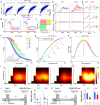Change-of-mind neuroeconomic decision-making is modulated by LINC00473 in medial prefrontal cortex in a sex-dependent manner
- PMID: 40644558
- PMCID: PMC12248383
- DOI: 10.1126/sciadv.adr3228
Change-of-mind neuroeconomic decision-making is modulated by LINC00473 in medial prefrontal cortex in a sex-dependent manner
Abstract
Changing one's mind involves reappraisals between past costs versus future value and may be altered in psychopathology. Long intergenic noncoding RNA LINC00473 in medial prefrontal cortex (mPFC) can induce stress resilience in a sex-dependent manner, but its role in cognition is unknown. We characterized decision-making behavior in male and female mice in the neuroeconomic paradigm Restaurant Row following virus-mediated expression of LINC00473 in mPFC. Mice foraged for food among varying temporal costs and subjective value while on a limited time budget. Without affecting primary deliberative decisions, LINC00473 selectively influenced re-evaluative choices in a sex-dependent manner. This included changing how mice (i) cached value with the passage of time and (ii) weighed prior mistakes, which underlie the computational bases of sensitivity to sunk costs and regret. These findings suggest that a common value function is shared between these neuroeconomic processes and reveal a bridge between molecular drivers of stress resilience and psychological mechanisms underlying sex-specific proclivities in negative rumination.
Figures







Update of
-
Change-of-mind neuroeconomic decision-making is modulated by LINC00473 in medial prefrontal cortex in a sex-dependent manner.bioRxiv [Preprint]. 2025 May 17:2024.05.08.592609. doi: 10.1101/2024.05.08.592609. bioRxiv. 2025. Update in: Sci Adv. 2025 Jul 11;11(28):eadr3228. doi: 10.1126/sciadv.adr3228. PMID: 39005412 Free PMC article. Updated. Preprint.
Similar articles
-
Change-of-mind neuroeconomic decision-making is modulated by LINC00473 in medial prefrontal cortex in a sex-dependent manner.bioRxiv [Preprint]. 2025 May 17:2024.05.08.592609. doi: 10.1101/2024.05.08.592609. bioRxiv. 2025. Update in: Sci Adv. 2025 Jul 11;11(28):eadr3228. doi: 10.1126/sciadv.adr3228. PMID: 39005412 Free PMC article. Updated. Preprint.
-
Peripuberty Is a Sensitive Period for Prefrontal Parvalbumin Interneuron Activity to Impact Adult Cognitive Flexibility.Dev Neurosci. 2025;47(2):127-138. doi: 10.1159/000539584. Epub 2024 Jun 3. Dev Neurosci. 2025. PMID: 38830346 Free PMC article.
-
A Double Hit of Social and Economic Stress in Mice Precipitates Changes in Decision-Making Strategies.Biol Psychiatry. 2024 Jul 1;96(1):67-78. doi: 10.1016/j.biopsych.2023.12.011. Epub 2023 Dec 21. Biol Psychiatry. 2024. PMID: 38141911 Free PMC article.
-
Interventions for supporting pregnant women's decision-making about mode of birth after a caesarean.Cochrane Database Syst Rev. 2013 Jul 30;2013(7):CD010041. doi: 10.1002/14651858.CD010041.pub2. Cochrane Database Syst Rev. 2013. PMID: 23897547 Free PMC article.
-
Management of urinary stones by experts in stone disease (ESD 2025).Arch Ital Urol Androl. 2025 Jun 30;97(2):14085. doi: 10.4081/aiua.2025.14085. Epub 2025 Jun 30. Arch Ital Urol Androl. 2025. PMID: 40583613 Review.
References
-
- Stone C., Mattingley J. B., Rangelov D., On second thoughts: Changes of mind in decision-making. Trends Cogn. Sci. 26, 419–431 (2022). - PubMed
-
- A. D. Redish, The Mind within the Brain: How We Make Decisions and How those Decisions Go Wrong (Oxford Univ. Press, 2013).
MeSH terms
Substances
Grants and funding
LinkOut - more resources
Full Text Sources
Miscellaneous

